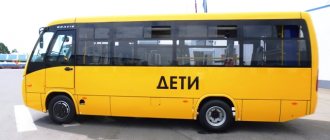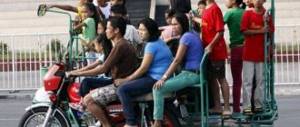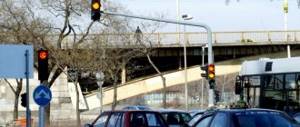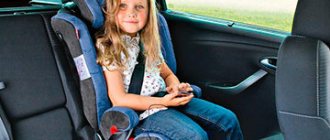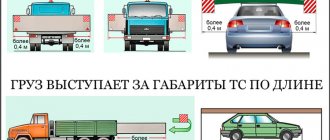Identification sign “Transportation of children” on buses
The placement of this sign indicates that there are children in the vehicle. Such transportation can be carried out only if all legal norms are observed, since their violation may result in serious administrative punishment, which extends from drivers to officials.
The sign is an identification sign; it indicates the fact of organized transportation. The sign must be located on both the front and rear of the bus.
The presence of such a sign indicates the performance of certain functions:
- notifies all other road users about the presence of children in the vehicle;
- enables the traffic police to organize traffic in accordance with priorities.
Also, the identification mark gives the following characteristics to the bus that carries out transportation:
- children traveling in the cabin in the amount of 8 or more people;
- there are children in the cabin without official representatives;
- The speed of the vehicle is limited in accordance with the Traffic Rules.
The age of children traveling in a vehicle with the “Transportation of Children” sign is not specified either in Resolution No. 1177 or in clause 22.6 of the Traffic Regulations.
Previously, drivers could find such information in the “Technical Requirements for Buses for Transporting Children,” Chapter 1. It was stated there that these requirements apply to vehicles carrying children aged 6 to 16 years on board, and the standard is intended only for travel in roads of the Russian Federation.
Sign on transport
According to the Traffic Rules, the standard by which children are transported is determined. Buses must always have a special “Children” sign, a sign warning all drivers to be careful on the highway.
It is analogous to pointer 1.23, but has the appearance of a square, circled around the edges in red, and a pair of guys running on a yellow background. It is placed on the glass in front and on the rear of transport vehicles.
The dimensions of such signs are established by law, which is covered in clause 22.6 of the traffic rules.
Sign standards:
- When placing a photo or image sticker on the front of the body, the width and length of the square is 25 x 25 cm.
- A 40 x 40 cm plate is placed on the rear body.
“Caution Children” sign is a picture of an identifying characteristic indicating organized transportation. It must be present on vehicles; otherwise, if it is not in visible places, a fine will be imposed.
Nowadays, purchasing these signs is not a problem, and many people print them for free on their own. You can buy standard photographs of the triangle “Children” sign, which is glued to a hard base such as the front and rear windows of buses transporting minors. Their price depends on the size of the “Children” road sign stickers. It can range from the cheapest 60 to 450 rubles.
The driver must follow the rules for transporting children:
- All passengers are provided with soft seats and are accompanied by an adult.
- It is not allowed to transport children standing.
- The bus should not travel faster than 60 km/h.
- When landing, the driver must turn on the emergency mode - light alarm; failure to comply with the procedure may result in a fine.
The absence of identification marks on transport threatens with a warning or a penalty or payment of 500 rubles.
The traffic pattern is approved in advance by the relevant authorities. Carrying cargo along the way is prohibited; hand luggage is allowed, as well as children’s belongings.
The driver cannot leave the vehicle while there are minor passengers in it. When moving in a column, a bus should not overtake it.
When transporting young children, personal cars and taxis do not need to affix an identification triangle with a “Children” road sign.
"Children" sign for a bus according to GOST
You can purchase such a sign without any problems at any car store, but you should know that it must meet certain requirements established by law.
The sign was developed according to the provisions of the Vienna Convention, which regulates the rules for printing and placement of such signs. Such stickers usually look the same: it is a yellow square with a red border, in the center of which there are two black silhouettes of running children.
The size will depend on the location on the bus:
- When the sign is placed on the front of the bus, its dimensions are 25 cm.
- If placed on the back - 40 cm.
- The width of the red border is always 0.1 part of the side.
If such standards are not met, the traffic police have every right to fine the driver.
The rules regarding the installation and fort of the sign are specified in the Rules of the Road. At the moment, this information is located in paragraph 9.3.
There are also special GOSTs related to the requirements imposed on the vehicle on which transportation will be carried out. At the moment this is GOST R 51160-98.
The sign should be positioned as follows:
- in front - on the windshield in the upper right part, as this will not interfere with the view;
- rear - place on a metal door.
The cost of a sign varies depending on its size and material of manufacture:
- 60*25/60*30 cm, made of polyvinyl chloride with a calendered surface, covered with mounting film - 300/400 rubles;
- 25*25/30*30 cm, made of polyvinyl chloride with a calendered surface, covered with mounting film - 60/90 rubles;
- 25*25/30*30 cm, printed on PVC, after which the image is glued to a rigid base - 350/450 rubles.
Identification sign “transportation of children” on buses from April 2021
By Decree of the Government of the Russian Federation dated March 24, 2017 N 333, amendments were made to the traffic rules, according to which the absence of identification marks is included in the list of conditions and malfunctions due to which the operation of a car is prohibited.
the appendix to the Basic Provisions for the admission of vehicles to operation and the responsibilities of officials to ensure road safety (List of faults and conditions under which the operation of vehicles is prohibited) shall be supplemented with clause 7.15 (1) with the following content: There are no identification marks that must be installed in accordance with paragraph 8 of the Basic Provisions for the admission of vehicles to operation and the duties of officials to ensure road safety, approved by Resolution of the Council of Ministers - Government of the Russian Federation of October 23, 1993 N 1090 “On traffic rules.
Decree of the Government of the Russian Federation of March 24, 2017 N 333
Which raises the question: is the “children in the car” sign mandatory or not in 2021?
Here we are talking exclusively about buses; passenger cars do not fall under this requirement.
According to traffic regulations, the list of identification signs that must be installed on the bus includes the “Transportation of Children” sign.
In particular, in paragraph 8. The main provisions for the admission of vehicles to operation and the responsibilities of officials to ensure road safety establish that identification marks must be installed on vehicles, including “Transportation of children” - in the form of a yellow square with a red border (border width - 1/10 of the side), with a black image of the symbol of the road sign 1.23 (the side of the square of the identification sign located at the front of the vehicle must be at least 250 mm, at the rear - 400 mm).
According to clause 8 of the Basic Provisions for the approval of a vehicle for operation, the identification mark “Transportation of Children” looks like this:
Please note that the requirement to install the “Transportation of Children” sign is mandatory only for buses transporting children. Read below about when it is necessary to install a “transportation of children” sign on a car (bus).
As for whether it is necessary to put up a “children in the car” sign, the traffic regulations do not contain any mandatory requirements for the presence of this sign on a passenger car. Therefore, drivers independently decide whether to install it or not.
Fine for missing a sign
If there is a negligent attitude to the rules and the absence of an identification mark, the driver is subject to administrative liability. According to Resolution No. 333 of March 24, 2017, punishment is imposed and applied based on the conditions specified in Article 12.5 Part 1 of the Code of Administrative Offenses of the Russian Federation. This could be either a warning or a fine of 500 rubles. The traffic police officer has the right to determine the punishment based on the situation.
Fine for not having a sign about transporting “children” on a bus in 2021
If there are no “Transportation of Children” identification signs on the front and (or) back of the bus that transports children, then the driver will face a warning or a fine for transporting children without a sign on the basis of Part 1 of Art. 12.5 of the Code of Administrative Offenses of the Russian Federation in the amount of 500 rubles.
Driving a vehicle in the presence of malfunctions or conditions under which, in accordance with the Basic Provisions for the admission of vehicles to operation and the duties of officials to ensure road safety, operation of the vehicle is prohibited, with the exception of malfunctions and conditions specified in parts 2 - 7 of this article , - entails a warning or the imposition of an administrative fine in the amount of five hundred rubles.
Part 1 Art. 12.5 Code of Administrative Offenses of the Russian Federation
Rules for organized transportation
According to traffic rules, organized transportation of children is a trip in which there are at least 8 children unaccompanied by parents in a vehicle that is not a route vehicle.
Transportation is possible only after fulfilling all the requirements for:
- driver;
- passengers;
- bus;
- documents.
The transportation rules include the following points:
- traffic police officers provide escort;
- the driver must meet all requirements;
- prepare a package of documents for the trip;
- ensuring compliance with requirements by accompanying persons;
- follow the rules for boarding/disembarking passengers on the bus.
Support by the State Inspectorate
The traffic police should accompany the trip only if it is a convoy with at least 3 vehicles in it.
The organizer must obtain permission to transport children, and then give the original to the driver, who must keep it in the vehicle for 3 days from the start of the trip and present it to the traffic police officer upon request. If the number of buses does not exceed 3, then an application for travel permission can be submitted approximately 2 days before the trip, and if from 3, then 10 days before. To find out how the application procedure goes and what else is needed for this, you can go to the official website of the State Traffic Inspectorate.
Transportation under parental supervision
Parents or guardians on the bus are not considered accompanying persons, which means that the trip loses the status of organized transportation, which is why the rules listed above and below do not apply to it.
Documentation
We will consider all the necessary documents for organized transportation.
Traffic police document
When drawing up an application for permission to organize transportation, the following information should be indicated:
- travel route;
- duration of support;
- attendant's initials;
- drivers' initials, details of their driver's license;
- number of passengers;
- license plates of buses.
Data on the trip of 1 or 2 buses must also be transferred to the traffic police. Please indicate:
- date of transportation;
- information about the company that organized the trip;
- number of minor passengers and their age;
- travel route;
- attendant's initials;
- make and license plate number of the bus.
List of children and designated chaperones
The list must indicate the child’s last name, first name and patronymic, his age and, necessarily, the contact telephone number of his parents or guardians. In the list of assigned accompanying persons, just as in the case of the list of children, it is necessary to indicate first names, last names and patronymics, as well as their telephone numbers.
Driver's document
Here his name, surname, patronymic and telephone number are indicated. If there are several drivers, then several contacts are indicated. We're not talking about a driver's license. The trip organizer must prepare a separate document containing information about the carrier.
Route program
The route program includes:
- travel schedule with estimated transportation time;
- a list of stops so that there is an opportunity to relieve physiological needs, eat, relax, and also go on excursions.
Additional documents
Sometimes the following additional documents may be required:
- a travel contract signed by the transport company and the customer, if it was concluded;
- medical worker's document;
- license to carry out medical activities;
- a list of necessary food products if the trip lasts more than 3 hours;
- list of tourism operator employees.
Requirements for drivers and transport
According to clause 8 of RF PP No. 1177, a driver will be able to drive a bus with children if he has:
- driving license category D;
- driving experience of driving a bus directly must be at least one year out of the last 3 years;
- completed instructions on transporting children;
- were not found guilty of administrative offenses under Chapter 12 of the Code of Administrative Offenses of the Russian Federation;
- he was not deprived of his rights;
- medical access.
This resolution also describes the requirements for the bus:
- the bus must be under 10 years old;
- it must meet technical requirements;
- a document confirming the passage of a technical inspection confirming the serviceability of the bus;
- There must be a tachograph - a device that will monitor the speed of the bus and the driver’s work and rest schedule.
Requirements for the driver of organized transportation of children
According to clause 8 of the Russian Federation Regulations dated December 17, 2013 N 1177, a driver is allowed to transport children who:
has at least 1 year of driving experience category D;
was not deprived of a driver's license and was not arrested for administrative violations of Chapter 12 of the Code of Administrative Offenses of the Russian Federation over the past year;
underwent pre-trip briefing and medical examination.
Drivers who meet the following requirements are allowed to drive buses carrying out organized transportation of a group of children: - having worked as a driver of a category “D” vehicle for at least one year out of the last 3 calendar years; - have not committed administrative offenses in the field of road traffic, for which administrative punishment is provided in the form of deprivation of the right to drive a vehicle or administrative arrest, during the last year; — have undergone pre-trip instruction on the safety of transporting children in accordance with the rules for ensuring the safety of transportation of passengers and cargo by road and urban ground electric transport, approved by the Ministry of Transport of the Russian Federation; - have undergone a pre-trip medical examination in the manner established by the Ministry of Health of the Russian Federation.”
Clause 8 of the Russian Federation Regulations dated December 17, 2013 N 1177
Rules for boarding and disembarking
On the way, the rules for getting in and out of the vehicle must be followed. Before placing children on the bus, the following measures must be taken:
- Check the presence of children according to the previously approved list.
- Gather children no less than 15 meters from the landing site.
- Load luggage.
- Check your hand luggage and how it is packed in accordance with the Rules.
- Discuss with the accompanying persons all the nuances and questions of the following nature: how to behave while driving and at stops;
- how passengers will board and disembark;
- how to behave in emergency situations or in case of health problems.
The task of the accompanying persons is to monitor the condition, well-being, behavior of the children, as well as what they eat.
Boarding begins only after the vehicle has stopped. The accompanying pairs bring the children to the front door of the bus, take them inside, and then seat them. It is also necessary to ensure that hand luggage is placed so that it does not injure anyone or obscure the driver’s view. Inform the driver about the end of boarding.
The adults leave the bus first. At stops, one adult stands at the back of the vehicle, and the second at the front. Their task is to prevent children from running out onto the road.
Transportation at night
According to Decree of the Government of the Russian Federation No. 1177 of December 17, 2013, at night (from 11 pm to 6 am), the route distance cannot exceed more than 100 km, and you can only go if necessary:
- transport to or from railway stations, airports;
- to the final destination;
- in case of unplanned delay.
If these resolutions were violated, then in accordance with Part 5 of Article 12.23 of the Code of Administrative Offenses of the Russian Federation one of the following penalties will be applied:
- for the driver the fine is 5,000 rubles. or deprivation of a driver's license for a period of 4 to 6 months;
- for officials the fine is 50,000 rubles;
- for legal entities - 200,000 rubles. fine
It should be understood that the process of transporting children is strictly controlled by current legislation, since the safety of children is an important issue and should not be neglected. Any violation of all basic rules may result in serious problems with the law and its representatives.


